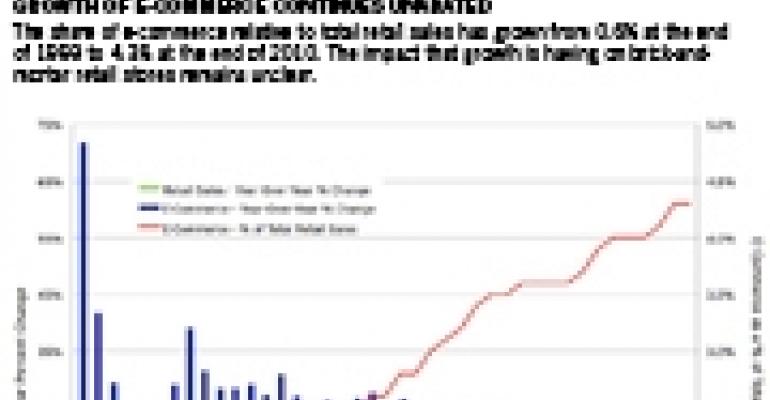With a larger share of retail sales migrating to online channels, what fate awaits traditional physical retail centers? Supply and vacancy patterns for retail properties across the nation hint at a rocky future for retail landlords.
Data from the U.S. Census Bureau over the last decade quantifies what shoppers have known for some time — a growing number of consumers are shopping on the Internet. Close to $165 billion of transactions occurred on the Internet in 2010, a 14.9% jump from 2009. Total retail sales grew by just 7% during the same period.
On average, total retail sales have grown by 2.9% year-over-year from 2001 to 2010. E-commerce sales eclipsed that by several orders of magnitude, clocking in at an average year-over-year growth rate of 20.2% during the same time period.

The share of e-commerce relative to total retail sales has grown from 0.6% at the end of 1999 to 4.3% at the end of 2010. Since the denominator for total retail sales includes figures from categories like motor vehicle and parts and gasoline stations, the overall percentages vastly understate the impact of e-commerce on specific lines of business.
The demise of Virgin megastores in the United States and United Kingdom, and the bankruptcies of Circuit City, Blockbuster and Borders are examples of retail chains that have been upended by the Internet.
Calm before the storm
How did shopping centers fare from 2001 to 2010? From 2001 to 2008, the growth in e-commerce failed to dampen the enthusiasm of developers. An average of 25.5 million sq. ft. of neighborhood and community center space was completed annually across the nation during that period, about the same average annual rate of construction from 1991 to 2000. Vacancies also were relatively tight, hovering at around 6.9%.
However, this ebullience masked structural weaknesses that were exposed when the recession pulled the plug on consumer spending. The nation was flooded with retail space, much of it attached to communities that sprung out of the ground because of the housing boom.
It didn’t take long for retail space to suffer from the housing market crash. Retail vacancies began to inch upward in late 2007, well before the Bureau of Labor Statistics recorded jobs being lost at the national level in February 2008.
Reis recorded its first instance of negative net absorption for retail space in the second quarter of 2008 — several months before Lehman Brothers fell and the National Bureau of Economic Research officially declared that the recession had begun in December 2007.
Even as the economy emerged from the recession, retail vacancies continued skyrocketing, ending 2010 at 10.9%, the highest level in 19 years. Sometime in 2011, Reis expects vacancies to float higher than the 11.1% historic high last recorded in 1990.
The so-called Great Recession marked the first time in 17 years that consumers pulled back from spending, and physical retail space continues to suffer for its long-running optimism in building.
The future of retail space
It is unlikely that retail stores will go the way of the horse and buggy when faced with the advent of the Internet’s version of the automobile. A more fitting analogy is the coexistence of motion picture houses and home movie systems. Consumers will benefit from having a wider range of choices for making purchase decisions, but brick-and-mortar retailers will face the constant threat of comparable or better deals offered by online sellers.
There are notable successes in the creative use of physical retail space. Apple retail stores attract a vast amount of foot traffic, but they are more like showrooms for Apple’s products. Unlike Best Buy, Apple stores carry only Apple products, and the stores essentially serve as a conduit, or substitute, for placing orders online. Still, the Apple example of offering an integrated physical and online shopping experience is instructive.
Developers and managers of retail centers need to think carefully about the value they offer to consumers. Is their center the only one within a circumscribed trade area protected by strict zoning or building laws? What unique physical shopping experience do they offer that might draw consumers to patronize their retail tenants? How can they ensure that consumers will purchase products on the premises, instead of heading back home to check for better deals online?
The road ahead
Even the coexistence paradigm implies a rough road ahead for retail properties, given the disruptive nature of online channels. The number of motion picture houses declined by close to 25% from 1992 to 2007, according to the 2007 Economic Census.
Unless the pace of shopping center demolitions or repurposing increases, the sector may have to deal with higher average vacancy levels over the next few years. Reis expects that the average vacancy for neighborhood and community centers will hover around 10% from 2011 to 2015.
However, what is retail’s bane may prove to be a blessing for other commercial real estate sectors. After all, as more online retailers ship physical products, they will need warehouse space to store some minimum level of inventory for efficient order fulfillment.
Victor Calanog is head of research and economics for New York-based research firm Reis.

